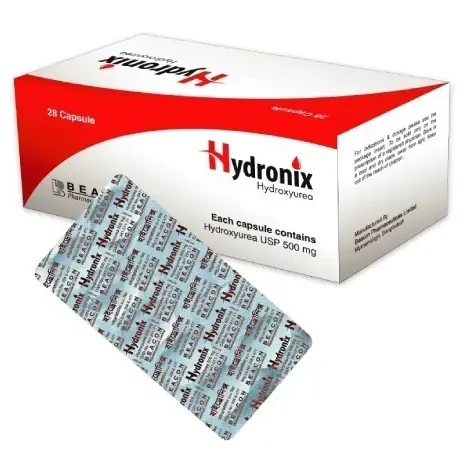Unit Price:
৳ 18.00
(7 x 4: ৳ 504.00)
Strip Price:
৳ 72.00
Indications
Hydronix is indicated for the treatment of:
- Polycythaemia vera
- Essential thrombocythemia
- Sickle cell anemia
- Resistant chronic myeloid leukemia
- Locally advanced squamous cell carcinomas of the head and neck in combination with chemoradiation.
Pharmacology
Hydroxyurea is converted to a free radical nitroxide (NO) in vivo, and transported by diffusion into cells where it quenches the tyrosyl free radical at the active site of the M2 protein subunit of ribonucleotide reductase, inactivating the enzyme. The entire replicase complex, including ribonucleotide reductase, is inactivated and DNA synthesis is selectively inhibited, producing cell death in S phase and synchronization of the fraction of cells that survive. Repair of DNA damaged by chemicals or irradiation is also inhibited by hydroxyurea, offering potential synergy between hydroxyurea and radiation or alkylating agents. Hydroxyurea also increases the level of fetal hemoglobin, leading to a reduction in the incidence of vasoocclusive crises in sickle cell anemia. Levels of fetal hemoglobin increase in response to activation of soluble guanylyl cyclase (sGC) by hydroxyurea-derived NO.
Dosage & Administration
Polycythaemia Vera: Administer 15-20 mg/kg orally once daily.
Essential Thrombocythemia: Administer 15 mg/kg orally once daily.
Solid Tumors- Intermittent Therapy: Administer 80 mg/kg orally every three days. Continuous Therapy: Administer 20-30 mg/kg orally once daily (qDay)
Head & Neck Tumors: Start 80 mg/kg orally every three days (q3days) seven days before initiating irradiation.
Chronic Myelocytic Leukemia, Resistant: Administer 20-40 mg/kg orally once daily.
Sickle Cell Disease: Initiate at 15 mg/kg/day as a single dose; monitor blood cell counts every two weeks. Titrate by 5 mg/kg/day every 12 weeks, but do not exceed 35 mg/kg/day.
Essential Thrombocythemia: Administer 15 mg/kg orally once daily.
Solid Tumors- Intermittent Therapy: Administer 80 mg/kg orally every three days. Continuous Therapy: Administer 20-30 mg/kg orally once daily (qDay)
Head & Neck Tumors: Start 80 mg/kg orally every three days (q3days) seven days before initiating irradiation.
Chronic Myelocytic Leukemia, Resistant: Administer 20-40 mg/kg orally once daily.
Sickle Cell Disease: Initiate at 15 mg/kg/day as a single dose; monitor blood cell counts every two weeks. Titrate by 5 mg/kg/day every 12 weeks, but do not exceed 35 mg/kg/day.
Interaction
Hydronix can enhance toxicity when used alongside antiretroviral drugs and may also interfere with laboratory tests measuring uric acid, urea, or lactic acid levels.
Contraindications
Hydroxyurea is contraindicated in patients who have demonstrated a previous hypersensitivity to hydroxyurea or any other component of the formulation.
Side Effects
- Fever
- Feeling very tired
- Chills
- Shortness of breath
- Body aches
- Bleeding or unexplained bruising
Pregnancy & Lactation
Pregnancy category D. There are no adequate and well-controlled studies in pregnant women. There are potential risk to fetus and women should avoid becoming pregnant while being treated with hydroxyurea. It is excreted in human milk. Because of the potential for serious adverse reactions in a breastfed infant from hydroxyurea, including carcinogenicity, patients should be discontinue breastfeeding during treatment with hydroxyurea.
Precautions & Warnings
Myelosuppression: Hydronix causes severe myelosuppression. Treatment with Hydronix should not be initiated if bone marrow function is markedly depressed. Bone marrow suppression may occur, and leukopenia is generally its first and most common manifestation. Some patients, treated at the recommended initial dose of 15 mg/kg/day, have experienced severe or life-threatening myelosuppression.
Malignancies: Hydronix is a human carcinogen. In patients receiving long-term Hydronix for myeloproliferative disorders, secondary leukemia has been reported. Skin cancer has also been reported in patients receiving long-term Hydronix. Advise protection from sun exposure and monitor for the development of secondary malignancies.
Embryo-Fetal Toxicity: Based on the mechanism of action and findings in animals, Hydronix can cause fetal harm when administered to a pregnant woman.
Malignancies: Hydronix is a human carcinogen. In patients receiving long-term Hydronix for myeloproliferative disorders, secondary leukemia has been reported. Skin cancer has also been reported in patients receiving long-term Hydronix. Advise protection from sun exposure and monitor for the development of secondary malignancies.
Embryo-Fetal Toxicity: Based on the mechanism of action and findings in animals, Hydronix can cause fetal harm when administered to a pregnant woman.
Use in Special Populations
Hydronix can cause fetal harm based on findings from animal studies and the drug’s mechanism of action. There are no data with Hydronix use in pregnant women to inform a drug-associated risk. Hydronix is excreted in human milk. Because of the potential for serious adverse reactions in a breastfed infant from Hydronix, including carcinogenicity, discontinue breastfeeding during treatment with Hydronix.
Overdose Effects
Acute mucocutaneous toxicity has been reported in patients receiving Hydronix at dosages several times the therapeutic dose. Soreness, violet erythema, edema on palms and soles followed by scaling of hands and feet, severe generalized hyperpigmentation of the skin, and stomatitis have also been observed.
Therapeutic Class
Cytotoxic Chemotherapy
Storage Conditions
Store at or below 25°C, in a cool and dry place. Keep away from light. Keep out of the reach of children.


